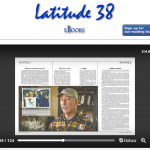Latitude 38 Magazine
Ten years ago, Captain Jim ‘Homer’ Holm was in Panama waiting for a weather window, when he came across a tiny island covered in trash and got an idea. Holm has been a sailing captain for some 40 years, running charters out of Hawaii and his native Santa Cruz. In 1996, he was hired by the O’Neill family to create an education program to teach kids marine science onboard their now-famed catamaran. Years later, Holm started another program at the Monterey Bay Aquarium, where they talked specifically about plastic in the ocean. “That was the beginning of my plastics education, and I just kind of got hooked. I really like doing that sort of thing,” Holm said. Eventually having to “go back to work,” Holm was on a delivery from California to the East Coast of the United States when he found himself in Panama. “We were waiting around for weather, and there was this island that was absolutely covered with plastic trash. And I knew that the people on that island didn’t produce all that trash. It motivated me to see if there was something I could do, and I’ve been doing it ever since.” In 2008, Holm helped start what would eventually become Clean Oceans International (COI). Holm says the origination emphasizes the conversion of plastic to fuel through the invention of small, inexpensive machines. “With the machines, local populations — especially islanders — will have the opportunity to recycle plastic, while at the same time creating a valuable product for their boats and equipment on their island,” Holm said. COI’s fi rst phase involves working with student volunteers who do basic research of plastic pollution on a given beach or shoreline, and produce data “with minimal fi nancial outlay and creating awareness of plastic pollution through community networking,” COI’s website said. Some of these “expedition” locations have included the British Virgin Islands, Alaska, the Hawaiian Islands, Brazil, Cuba and here in the East Bay. Albany High School’s Ocean Protection League worked with several organizations over multiple years to “conduct documentation surveys and remove toxic micro debris from their home beach,” which was found to be horribly polluted with plastic. For his part, Holm has focused on the plastic-to-diesel machine itself. “There’s a technology that allows us to basically cook plastic, and turn it into gasoline and diesel fuel. And the trick is that it’s profi table to do so, and it’s a lower carbon footprint than the way we create gasoline and diesel fuel now.” Holm said the concept of turning plastic into fuel is not a new technology, and has already been done on a larger, more expensive scale by numerous companies around the world. “But those operations made a fatal fl aw with their business model. To make a million dollars, they had to sell their fuel, and that put them in direct competition with people that had been selling fuel for decades. The sales part was the fl aw, and one by one they’ve gone belly up,” Holm said. During a TED Talk several years ago, Holm featured an earlier generation of “the Machine,” which is about the size of an old, non- fl at-screen TV, making it mobile. A later generation of the machine was designed by Dr. Swaminathan Ramesh, a polymer scientist in Michigan. Holm plans to take the machine on his recently purchased Fountaine Pajot Eleuthera 60 cat Pono and troll for plastic in the Sargasso Sea, a gyre in the Atlantic. He and his wife have been cruising the Med, attended the Our Oceans Conference in Malta, and plan to do education and research trips, “once we’ve got the machine on board.” We asked Holm if sailors could conceivably fuel themselves off found plastic in the sea. “It takes about 10 pounds of plastic to make a gallon, so it’s remotely possible, but it’s not practical. But you could certainly visit some of these remote islands, gather all the plastic there, and produce some of your own fuel.” For more information, go to www.cleanoceansinternational.org — tim
| l38201712.pdf | |
| File Size: | 23619 kb |
| File Type: | |

